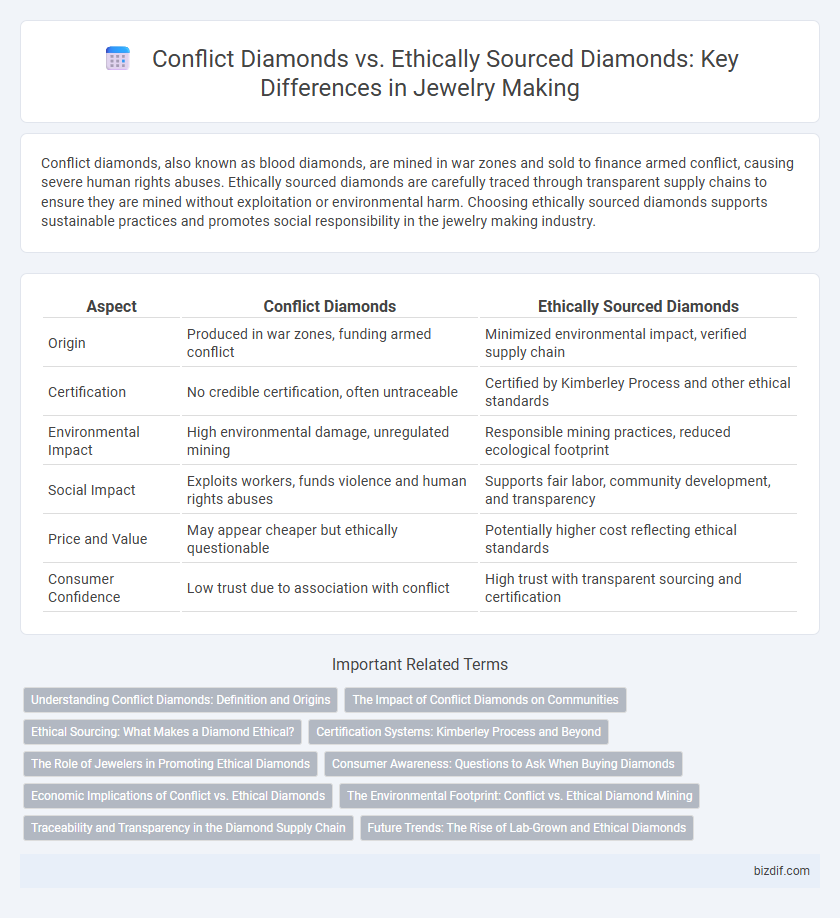Conflict diamonds, also known as blood diamonds, are mined in war zones and sold to finance armed conflict, causing severe human rights abuses. Ethically sourced diamonds are carefully traced through transparent supply chains to ensure they are mined without exploitation or environmental harm. Choosing ethically sourced diamonds supports sustainable practices and promotes social responsibility in the jewelry making industry.
Table of Comparison
| Aspect | Conflict Diamonds | Ethically Sourced Diamonds |
|---|---|---|
| Origin | Produced in war zones, funding armed conflict | Minimized environmental impact, verified supply chain |
| Certification | No credible certification, often untraceable | Certified by Kimberley Process and other ethical standards |
| Environmental Impact | High environmental damage, unregulated mining | Responsible mining practices, reduced ecological footprint |
| Social Impact | Exploits workers, funds violence and human rights abuses | Supports fair labor, community development, and transparency |
| Price and Value | May appear cheaper but ethically questionable | Potentially higher cost reflecting ethical standards |
| Consumer Confidence | Low trust due to association with conflict | High trust with transparent sourcing and certification |
Understanding Conflict Diamonds: Definition and Origins
Conflict diamonds, also known as blood diamonds, are gemstones mined in war zones and sold to finance armed conflict against governments. These diamonds often originate from regions like Sierra Leone, Angola, and the Democratic Republic of Congo, where rebel groups exploit mineral wealth to fund violence. Understanding the origins and impact of conflict diamonds highlights the importance of ethical sourcing practices to ensure diamonds are obtained without human rights abuses.
The Impact of Conflict Diamonds on Communities
Conflict diamonds, also known as blood diamonds, fuel violence and human rights abuses in mining regions, devastating local communities through forced labor and displacement. Ethically sourced diamonds, verified through initiatives like the Kimberley Process, support sustainable development by ensuring fair labor practices and community investment. Choosing ethically sourced diamonds promotes peace and socio-economic growth in diamond-producing areas.
Ethical Sourcing: What Makes a Diamond Ethical?
Ethically sourced diamonds are mined and traded under strict regulations that ensure fair labor practices, environmental sustainability, and community development. These diamonds are certified through transparent supply chains, such as the Kimberley Process and independent ethical certifications, preventing conflict financing and exploitation. Choosing ethically sourced diamonds supports responsible mining operations and promotes social responsibility in the jewelry industry.
Certification Systems: Kimberley Process and Beyond
The Kimberley Process Certification Scheme (KPCS) is a widely recognized system designed to prevent conflict diamonds from entering the global market by verifying their origin through government-issued certificates. However, its limitations have led to the rise of alternative certification systems like the Responsible Jewellery Council (RJC) and the Alliance for Responsible Mining (ARM), which emphasize broader ethical practices including environmental sustainability and fair labor conditions. Jewelers increasingly prefer ethically sourced diamonds certified by these comprehensive programs to ensure transparency and social responsibility in their supply chains.
The Role of Jewelers in Promoting Ethical Diamonds
Jewelers play a critical role in promoting ethically sourced diamonds by ensuring transparency in their supply chains and rejecting conflict diamonds linked to human rights abuses. Implementing certification programs like the Kimberley Process and partnering with trusted suppliers help jewelers guarantee the authenticity of conflict-free diamonds. Their commitment boosts consumer confidence and drives demand for ethically mined gemstones, fostering a more responsible jewelry industry.
Consumer Awareness: Questions to Ask When Buying Diamonds
Consumers should ask about the diamond's origin and request certification verifying ethical sourcing to avoid conflict diamonds. Inquiring about the retailer's supply chain transparency helps ensure the stones are conflict-free and comply with the Kimberley Process. Understanding the environmental and social impact of mined diamonds promotes responsible purchasing decisions in the jewelry market.
Economic Implications of Conflict vs. Ethical Diamonds
Conflict diamonds often fuel violence and destabilize economies in affected regions by financing armed groups, leading to long-term economic hardship and disrupted local markets. Ethically sourced diamonds support sustainable economic growth by ensuring fair wages, safe working conditions, and investments in community development, which promote stability and prosperity. The demand for ethical diamonds also incentivizes transparency and accountability in the jewelry supply chain, attracting socially conscious consumers and enhancing brand value.
The Environmental Footprint: Conflict vs. Ethical Diamond Mining
Conflict diamond mining causes severe environmental degradation, including deforestation, soil erosion, and water pollution due to unregulated extraction methods. Ethically sourced diamond mining prioritizes sustainable practices, utilizing advanced land reclamation techniques and minimizing ecological damage. Certified ethical diamonds often come from mines adhering to strict environmental standards, significantly reducing the overall environmental footprint compared to conflict diamonds.
Traceability and Transparency in the Diamond Supply Chain
Traceability in the diamond supply chain ensures each stone's origin is documented, significantly reducing the risk of conflict diamonds entering the market. Ethically sourced diamonds undergo rigorous certification processes, like the Kimberley Process, to guarantee transparency and compliance with labor and environmental standards. Advanced blockchain technologies enhance this transparency, allowing consumers to verify a diamond's ethical journey from mine to market.
Future Trends: The Rise of Lab-Grown and Ethical Diamonds
The jewelry industry is increasingly shifting towards lab-grown and ethically sourced diamonds, driven by consumer demand for transparency and sustainability. Lab-grown diamonds offer a conflict-free alternative with reduced environmental impact, gaining prominence as a future trend. Ethical sourcing practices, including rigorous supply chain audits and certification standards like the Kimberley Process, are reshaping diamond procurement to ensure social responsibility.
Conflict diamonds vs ethically sourced diamonds Infographic

 bizdif.com
bizdif.com